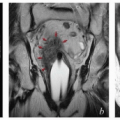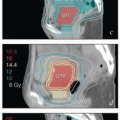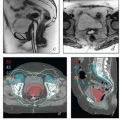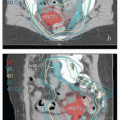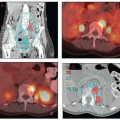Pathology, Molecular Biology, and Etiology of Gynecologic Cancers
INTRODUCTION
Radiation treatment recommendations for gynecologic cancers are guided primarily by the site of origin and the morphology of the primary tumor. Morphologically, similar gynecologic cancers from different sites of origin tend to share molecular features and demonstrate similar patterns of spread. However, even among morphologically similar cancers, the site of origin plays a critical role in the method and ease of initial cancer detection, the prognosis, and the patterns of regional spread (Chapter 5).
In recent years, research has greatly expanded our understanding of the molecular correlates of prognosis. Although the practical uses of this knowledge have focused primarily on refinements to diagnostic criteria, there is reason to hope that these findings will eventually contribute to the development of new, more effective treatments. In addition, better understanding of the roles of human papillomavirus (HPV) infection and heredity in the etiology of gynecologic cancers is leading to successful strategies for prevention of many cancers.
CORR ELATES BETWEEN MORPHOLOGY AND BIOLOGIC BEHAVIOR
Most gynecologic cancers fall into three major groups: carcinomas, sarcomas, and germ cell tumors. Among gynecologic cancers, carcinomas are much more common than other types of cancers.
Carcinomas arise from the squamous or glandular epithelial linings of the vulva, vagina, cervix, uterus, fallopian tubes, or ovaries and account for the vast majority of gynecologic cancers that are treated with radiation. Squamous carcinomas predominate in structures that are normally lined by squamous epithelium (vulva, vagina, and cervix), while adenocarcinomas predominate in structures that are lined with glandular epithelium (uterus, fallopian tubes, and ovaries). However, adenocarcinomas can also arise from glandular elements of lower genital tract structures, and areas of squamous differentiation can be a prominent feature in endometrial and, occasionally, ovarian cancers.
Carcinosarcomas are defined by the presence of both a malignant epithelial and a mesenchymal component; these tumors can originate throughout the female genital tract but are most commonly found in the endometrium and ovary.
Sarcomas are derived from the mesenchymal components of female genital tract structures. The most common of which are leiomyosarcomas, which are derived from smooth muscle of the uterus and other structures, and endometrial stromal sarcomas, which are derived from endometrial stroma. Rarely, cancers are derived from hormone-secreting ovarian stroma; these include granulosa cell tumors, which are derived from the sex cord and are comparable to testicular Sertoli cell tumors, and thecomas, which are derived from gonadal stroma and are comparable to Leydig cell tumors of the testis. Tumors that contain a mixture of granulosa cell tumor and thecoma are called Sertoli-Leydig cell tumors.
Germ cell tumors in females arise from the ovary and include teratomas, dysgerminomas, yolk sac tumors (also called endodermal sinus tumors), embryonal carcinomas, and choriocarcinomas. Germ cell tumors are rarely treated with radiation, as they generally have a favorable prognosis with surgery alone (teratomas) or are highly chemotherapy sensitive (choriocarcinomas, dysgerminomas).
Müllerian Adenocarcinomas
Most gynecologic adenocarcinomas arise from cells that had their origin in the embryologic müllerian duct (Chapter 5). The shared developmental origin of these müllerian carcinomas explains the shared behavioral and biologic characteristics of müllerian adenocarcinomas arising in various sites. Grade is an important prognostic factor for all types of adenocarcinoma.
Subtypes of Müllerian Adenocarcinoma
There are four major subtypes of müllerian adenocarcinoma:
Endometrioid carcinomas resemble normal endometrial glands in their differentiated state. The grade of endometrioid carcinomas is based on the percentage of the tumor area that has a solid growth pattern and tends to be correlated with the degree of nuclear atypia.
Mucinous carcinomas resemble normal endocervical glandular epithelium. Many cervical adenocarcinomas have mucinous features.1
Serous carcinomas resemble fallopian tube epithelium. They tend to have a papillary architectural pattern, but grade is based on cytologic features. Adnexal serous carcinomas can range from very low-grade lesions of uncertain malignant potential (so-called borderline tumors) to very pleomorphic, high-grade cancers. Serous carcinomas of any grade metastasize to peritoneal surfaces more frequently than other müllerian variants do. High- and low-grade serous carcinomas arise from the ovary, while uterine serous carcinomas are virtually always high-grade cancers.
Clear cell carcinomas have glycogen-rich cytoplasm, which gives them the characteristic appearance of cleared cytoplasm. Although clear cell carcinomas are believed to be of müllerian origin, their precise origins are uncertain.2
Variants of müllerian adenocarcinoma arise throughout the gynecologic tract with varying frequency; however, they tend to occur more frequently in the tissues that share their differentiated features, for example, endometrioid carcinomas in the endometrium, serous carcinomas in the ovary or fallopian tube, and endocervical-type mucinous carcinomas in the cervix.
Type I and Type II Histologic Variants of Endometrial and Ovarian Cancer
Endometrial and ovarian cancers demonstrate greater morphologic variability than do cancers at other gynecologic sites, and all subtypes of müllerian adenocarcinoma play a major role. Endometrial and ovarian cancers have sometimes been grouped according to their likelihood of demonstrating aggressive behavior.
Endometrial cancers are frequently divided according to their morphologic features and aggressiveness into type I and type II cancers. Type I cancers, which include endometrioid and the relatively rare mucinous carcinomas, typically present at an early stage and have a relatively favorable prognosis. Type I cancers are thought to frequently develop as a consequence of excess estrogen exposure, which triggers proliferation in the estrogen-responsive endometrial cells. A higher lifetime risk of estrogen exposure is seen in women with early menarche, fewer pregnancies, exogenous estrogen exposure, or obesity, which increases estrogen exposure through aromatization of androgens from peripheral adipose tissues. Type I endometrial cancers classically arise in a proliferative endometrium with complex hyperplasia, supporting the suggestion that estrogen exposure fosters the development of these cancers. Other risk factors for type I endometrial cancer include hypertension, diabetes, anovulation, and polycystic ovarian syndrome. Type II cancers, which include serous carcinomas, clear cell carcinomas, and in some descriptions, carcinosarcomas, are more aggressive. Type II cancers typically arise in an atrophic endometrium in older patients than the ones in which the type I variants arise.
Ovarian cancers have similarly been divided into type I and type II tumors.3 According to this classification, type I tumors include low-grade serous, low-grade endometrioid, clear cell, and mucinous carcinomas—subtypes that are more likely to present at an early stage and have a more indolent course. Type II tumors include high-grade serous and high-grade endometrioid subtypes, which are more likely to present at an advanced stage and have an aggressive course.
The various subtypes of müllerian adenocarcinoma are frequently admixed; in these cases, prognosis is usually dictated by the type II or highest grade lesion.
The gynecologic origins of müllerian adenocarcinomas can be traced by detecting the expression of PAX8. This transcriptional factor drives the development of müllerian tumors and is persistently expressed in many müllerian adenocarcinomas of gynecologic origin. Immunohistochemical staining for PAX8 can be used to determine the primary tumor site in the case of a metastatic tumor of unknown primary site.4
Squamous Carcinomas
Gynecologic squamous carcinomas arise predominantly from the squamous epithelium that lines the vulva, vagina, and cervix; most cancers involving lower genital tract sites are squamous. Although the cytologic grade of squamous carcinomas varies, grade is at most weakly correlated with prognosis. Squamous carcinomas of gynecologic origin, as well as squamous cancers arising at other mucosal sites, such as the head and neck, tend to behave more predictably than cancers of other histologic subtypes, first invading locally and then disseminating to regional lymph nodes before distant sites. HPV plays a critical role in the development of many gynecologic squamous carcinomas.
MOLECULAR BIOLOGY OF GYNECOLOGIC CANCERS
Methods of Molecular Characterization
Immunohistochemical techniques have played a critical role in advancing our understanding of the molecular features of gynecologic cancers. Immunohistochemical tests involve incubation of a labeled antibody on fixed, paraffin-embedded sections. The staining intensity is scored qualitatively, and generally only a single marker can be tested at a time. Because immunohistochemical studies are performed on fixed, paraffin-embedded tissue, these markers were most readily incorporated into practice. Many immunohistochemical markers with diagnostic, predictive, and prognostic potential in gynecologic cancer have been identified, but few have been developed into clinically useful tools.
More recently, techniques to comprehensively survey gene expression, copy number, and mutations (genomics) and protein expression (proteomics) have become more feasible. These techniques survey the entire landscape of a tumor rather than focusing on a single gene or protein. As a result, these studies can be used to simultaneously evaluate the functionality of hundreds of pathways. As the number of biologically targeted agents expands, the hope is that treatments can be tailored to the molecular profile of each patient’s tumor. This approach holds great promise but remains investigational and is employed primarily in patients with advanced and recurrent disease. To date, molecular features have not proven to reliably identify which patients with gynecologic cancers will benefit from radiation therapy, but this is an active area of investigation that is likely to bring changes to clinical practice in the next decade.
Correlation of Molecular Markers with Morphology and Prognosis
Several molecular features of gynecologic cancers have been found to correlate with morphology. For example, in type I endometrial cancer, molecular analysis frequently detects mismatch repair deficiencies with areas of repeating DNA sequences, called microsatellite instability; mutations in genes such as PTEN, KRAS, CDH1, and CTNNB1 are also common. In contrast, in type II endometrial cancer, mutations in TP53, ERBB2, and TERT are more common.
Type II, high-grade ovarian cancers have a higher rate of mutations in TP53 and greater genomic instability than type I cancers. Type II ovarian cancers are also more likely to have disruption of BRCA gene function because of genetic or epigenetic changes.3
Molecular features have also been correlated with prognosis. The Cancer Genome Atlas recently reported a comprehensive analysis of molecular changes in endometrial cancers. The authors performed whole-genome sequencing, gene expression, methylation, and copy number analyses on 373 endometrial cancers.5 Tumors were classified into four groups on the basis of features identified in the analysis. Of perhaps greatest interest was a small subgroup of tumors that had mutations in the catalytic subunit of DNA polymerase epsilon (POLE). These tumors were associated with an extremely favorable prognosis despite a high-grade, often serous, morphology; they were also characterized by tumor-infiltrating T cells and a high rate of mutations throughout the genome.5,6 The Cancer Genome Atlas analysis also identified a poor-prognosis group of tumors with a high rate of increases in the number of copies of genes. These tumors had frequent mutations in TP53 and included serous tumors, as well as 25% of grade 3 endometrioid cancers. In the future, these molecular subtypes may find clinical utility in the management of endometrial cancer.
Stay updated, free articles. Join our Telegram channel

Full access? Get Clinical Tree


